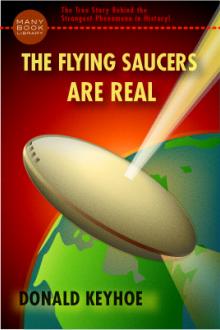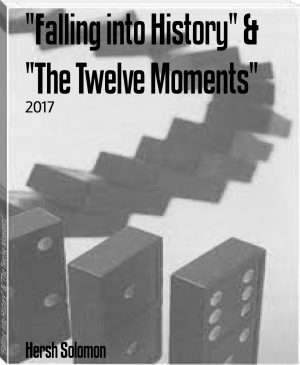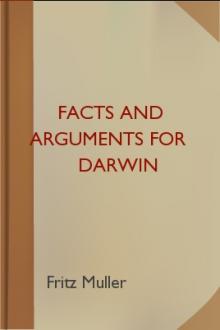The Expression of Emotion in Man and Animals by Charles Darwin (adult books to read TXT) 📕

- Author: Charles Darwin
- Performer: -
Book online «The Expression of Emotion in Man and Animals by Charles Darwin (adult books to read TXT) 📕». Author Charles Darwin
It is not necessary, in order to lead to the contraction of these muscles, that air should actually be expelled from the chest; it suffices that the muscles of the chest and abdomen should contract with great force, whilst by the closure of the glottis no air escapes.
In violent vomiting or retching the diaphragm is made to descend by the chest being filled with air; it is then held in this position by the closure of the glottis, “as well as by the contraction of its own fibres.”[13] The abdominal muscles now contract strongly upon the stomach, its proper muscles likewise contracting, and the contents are thus ejected.
During each effort of vomiting “the head becomes greatly congested, so that the features are red and swollen, and the large veins of the face and temples visibly dilated.” At the same time, as I know from observation, the muscles round the eyes are strongly contracted.
This is likewise the case when the abdominal muscles act downwards with unusual force in expelling the contents of the intestinal canal.
[13] See Dr. Brinton’s account of the act of vomiting, in Todd’s Cyclop.
of Anatomy and Physiology, 1859, vol. v. Supplement, p. 318.
The greatest exertion of the muscles of the body, if those of the chest are not brought into strong action in expelling or compressing the air within the lungs, does not lead to the contraction of the muscles round the eyes.
I have observed my sons using great force in gymnastic exercises, as in repeatedly raising their suspended bodies by their arms alone, and in lifting heavy weights from the ground, but there was hardly any trace of contraction in the muscles round the eyes.
As the contraction of these muscles for the protection of the eyes during violent expiration is indirectly, as we shall hereafter see, a fundamental element in several of our most important expressions, I was extremely anxious to ascertain how far Sir C. Bell’s view could be substantiated.
Professor Donders, of Utrecht,[14] well known as one of the highest authorities in Europe on vision and on the structure of the eye, has most kindly undertaken for me this investigation with the aid of the many ingenious mechanisms of modern science, and has published the results.[15] He shows that during violent expiration the external, the intra-ocular, and the retro-ocular vessels of the eye are all affected in two ways, namely by the increased pressure of the blood in the arteries, and by the return of the blood in the veins being impeded.
It is, therefore, certain that both the arteries and the veins of the eye are more or less distended during violent expiration.
The evidence in detail may be found in Professor Donders’
valuable memoir. We see the effects on the veins of the head, in their prominence, and in the purple colour of the face of a man who coughs violently from being half choked.
I may mention, on the same authority, that the whole eye certainly advances a little during each violent expiration.
This is due to the dilatation of the retro-ocular vessels, and might have been expected from the intimate connection of the eye and brain; the brain being known to rise and fall with each respiration, when a portion of the skull has been removed; and as may be seen along the unclosed sutures of infants’ heads.
This also, I presume, is the reason that the eyes of a strangled man appear as if they were starting from their sockets.
[14] I am greatly indebted to Mr. Bowman for having introduced me to Prof. Donders, and for his aid in persuading this great physiologist to undertake the investigation of the present subject.
I am likewise much indebted to Mr. Bowman for having given me, with the utmost kindness, information on many points.
[15] This memoir first appeared in the `Nederlandsch Archief voor Genees en Natuurkiinde,’ Deel 5, 1870. It has been translated by Dr. W. D. Moore, under the title of “On the Action of the Eyelids in determination of Blood from expiratory effort,” in `Archives of Medicine,’ edited by Dr. L. S. Beale, 1870, vol. v. p. 20.
With respect to the protection of the eye during violent expiratory efforts by the pressure of the eyelids, Professor Donders concludes from his various observations that this action certainly limits or entirely removes the dilatation of the vessels.[16] At such times, he adds, we not unfrequently see the hand involuntarily laid upon the eyelids, as if the better to support and defend the eyeball.
[16] Prof. Donders remarks (ibid. p. 28), that, “After injury to the eye, after operations, and in some forms of internal inflammation, we attach great value to the uniform support of the closed eyelids, and we increase this in many instances by the application of a bandage.
In both cases we carefully endeavour to avoid great expiratory pressure, the disadvantage of which is well known.” Mr. Bowman informs me that in the excessive photophobia, accompanying what is called scrofulous ophthalmia in children, when the light is so very painful that during weeks or months it is constantly excluded by the most forcible closure of the lids, he has often been struck on opening the lids by the paleness of the eye,—
not an unnatural paleness, but an absence of the redness that might have been expected when the surface is somewhat inflamed, as is then usually the case; and this paleness he is inclined to attribute to the forcible closure of the eyelids.
Nevertheless much evidence cannot at present be advanced to prove that the eye actually suffers injury from the want of support during violent expiration; but there is some.
It is “a fact that forcible expiratory efforts in violent coughing or vomiting, and especially in sneezing, sometimes give rise to ruptures of the little (external) vessels”
of the eye.[17] With respect to the internal vessels, Dr. Gunning has lately recorded a case of exophthalmos in consequence of whooping-cough, which in his opinion depended on the rupture of the deeper vessels; and another analogous case has been recorded. But a mere sense of discomfort would probably suffice to lead to the associated habit of protecting the eyeball by the contraction of the surrounding muscles.
Even the expectation or chance of injury would probably be sufficient, in the same manner as an object moving too near the eye induces involuntary winking of the eyelids.
We may, therefore, safely conclude from Sir C. Bell’s observations, and more especially from the more careful investigations by Professor Donders, that the firm closure of the eyelids during the screaming of children is an action full of meaning and of real service.
We have already seen that the contraction of the orbicular muscles leads to the drawing up of the upper lip, and consequently, if the mouth is kept widely open, to the drawing down of the corners by the contraction of the depressor muscles.
The formation of the naso-labial fold on the cheeks likewise follows from the drawing up of the upper lip. Thus all the chief expressive movements of the face during crying apparently result from the contraction of the muscles round the eyes.
We shall also find that the shedding of tears depends on, or at least stands in some connection with, the contraction of these same muscles.
[17] Donders, ibid. p. 36.
In some of the foregoing cases, especially in those of sneezing and coughing, it is possible that the contraction of the orbicular muscles may serve in addition to protect the eyes from too severe a jar or vibration.
I think so, because dogs and cats, in crunching hard bones, always close their eyelids, and at least sometimes in sneezing; though dogs do not do so whilst barking loudly. Mr. Sutton carefully observed for me a young orang and chimpanzee, and he found that both always closed their eyes in sneezing and coughing, but not whilst screaming violently.
I gave a small pinch of snuff to a monkey of the American division, namely, a Cebus, and it closed its eyelids whilst sneezing; but not on a subsequent occasion whilst uttering loud cries.
Cause of the secretion of tears.—It is an important fact which must be considered in any theory of the secretion of tears from the mind being affected, that whenever the muscles round the eyes are strongly and involuntarily contracted in order to compress the blood-vessels and thus to protect the eyes, tears are secreted, often in sufficient abundance to roll down the cheeks.
This occurs under the most opposite emotions, and under no emotion at all. The sole exception, and this is only a partial one, to the existence of a relation between the involuntary and strong contraction of these muscles and the secretion of tears is that of young infants, who, whilst screaming violently with their eyelids firmly closed, do not commonly weep until they have attained the age of from two to three or four months.
Their eyes, however, become suffused with tears at a much earlier age.
It would appear, as already remarked, that the lacrymal glands do not, from the want of practice or some other cause, come to full functional activity at a very early period of life.
With children at a somewhat later age, crying out or wailing from any distress is so regularly accompanied by the shedding of tears, that weeping and crying are synonymous terms.[18]
Under the opposite emotion of great joy or amusement, as long as laughter is moderate there is hardly any contraction of the muscles round the eyes, so that there is no frowning; but when peals of loud laughter are uttered, with rapid and violent spasmodic expirations, tears stream down the face.
I have more than once noticed the face of a person, after a paroxysm of violent laughter, and I could see that the orbicular muscles and those running to the upper lip were still partially contracted, which together with the tear-stained cheeks gave to the upper half of the face an expression not to be distinguished from that of a child still blubbering from grief.
The fact of tears streaming down the face during violent laughter is common to all the races of mankind, as we shall see in a future chapter.
In violent coughing especially when a person is half-choked, the face becomes purple, the veins distended, the orbicular muscles strongly contracted, and tears run down the cheeks. Even after a fit of ordinary coughing, almost every one has to wipe his eyes.
In violent vomiting or retching, as I have myself experienced and seen in others, the orbicular muscles are strongly contracted, and tears sometimes flow freely down the cheeks. It has been suggested to me that this may be due to irritating matter being injected into the nostrils, and causing by reflex action the secretion of tears.
Accordingly I asked one of my informants, a surgeon, to attend to the effects of retching when nothing was thrown up from the stomach; and, by an odd coincidence, he himself suffered the next morning from an attack of retching, and three days subsequently observed a lady under a similar attack; and he is certain that in neither case an atom of matter was ejected from the stomach; yet the orbicular muscles were strongly contracted, and tears freely secreted.
I can also speak positively to the energetic contraction of these same muscles round the eyes, and to the coincident free secretion of tears, when the abdominal muscles act with unusual force in a downward direction on the intestinal canal.
[18] Mr. Hensleigh Wedgwood (Dict. of English Etymology, 1859, vol. i. p. 410)





Comments (0)